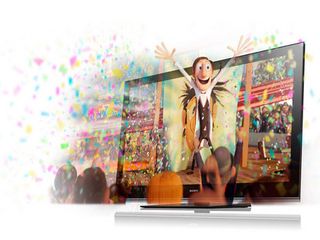Why you can trust TechRadar

The depth in the opening street scenes of Monster House on Blu-ray is fantastic, though immediately there's a problem; falling autumn leaves are lifted from the background, for sure, but fall too fast for the panel. The 3D effect is accompanied by disorientating flicker and double images of each leaf.
Aside from causing a slight flicker to the picture at all times, the shutter glasses remove a chunk of brightness (though not nearly as much as a 3D plasma) and add a slight green tinge to images.
Brightness might be the first casualty of the glasses, but they do appear to add some extra perceived contrast.
Some crosstalk (a slight echo of each left and right image to either side of a 3D object) is also discernible, particularly so with a PlayStation3. On WipEout HD there's plenty of depth effects and backgrounds are deep, detailed and impressively smooth as they whizz by.
The craft itself however, proves to be a vessel for a noticeable amount of crosstalk. It's not that the 3D image is destroyed, but you won't be able to miss an echo of the craft on each side (although if you're lucky, you may only see one echo). It's fainter than the actual craft itself, but not by much.
Does it hamper the 3D effect completely? Not quite, but it's a problem that only affects LCD TVs, LED-backlit or not, thereby ceding a significant advantage to plasma where 3D is concerned.
WipEout HD's in-game graphics plonk the positional indicator, lap counter and timer as fixed 2D elements at the front of the screen, which helps add an immediate sense of depth.
Gran Turismo 5 doesn't play in 3D unless you go into 'options', 'hardware', then '3DTV', and turn 3DTV mode on. Why it doesn't activate automatically is anyone's guess. It adds depth, but it's a mild effect that adds surprisingly little to the enjoyment of the game. Choose to play in 3D and the quality goes down to 720p, which does create the odd jagged edge, though there's an almost constant slight jerkiness to the picture.
Without the 3D glasses, the 40LX903's 2D image is first rate. Best of all, it is imbued with excellent contrast. Loads of shadow details are apparent in a 2D Blu-ray test disc of 2012, though the LEDs in the bottom left-hand corner of the screen on our review sample were noticeably brighter than the others. This kind of light leakage is noticeable on most Edge LED-lit LCD TVs, but that doesn't excuse it.
There's an extraordinary colour range on show in 2012 as Los Angeles collapses, with hundreds of elements each treated to varying hues and pin-sharp saturations.
The effect of the MotionFlow 200Hz feature is a more fluid image that's not blighted by any serious amount of blur or loss of resolution. Used on its highest setting 2012 looks even more laden with special effects than it really is, though it's worth experimenting with, since it does lose the judder from Blu-ray discs that some find irritating.
More enticing is the 40LX903's reasonable efforts at upscaling standard-definition sources; DVDs in particular, and most Freeview channels, are highly watchable.
Current page: Sony Bravia KDL40LX903: Picture
Prev Page Sony Bravia KDL40LX903: Features Next Page Sony KDL40LX903: Sound, value, ease of useJamie is a freelance tech, travel and space journalist based in the UK. He’s been writing regularly for Techradar since it was launched in 2008 and also writes regularly for Forbes, The Telegraph, the South China Morning Post, Sky & Telescope and the Sky At Night magazine as well as other Future titles T3, Digital Camera World, All About Space and Space.com. He also edits two of his own websites, TravGear.com and WhenIsTheNextEclipse.com that reflect his obsession with travel gear and solar eclipse travel. He is the author of A Stargazing Program For Beginners (Springer, 2015),

An incredible $100 billion bet to get rid of Nvidia dependence — tech experts reckon Microsoft will build a million-server strong data center that will primarily use critical inhouse components

The real total eclipse was better than the pics I shot with my iPhone 15 Pro Max and DSLR, and believe me I tried

Quordle today – hints and answers for Sunday, April 14 (game #811)

